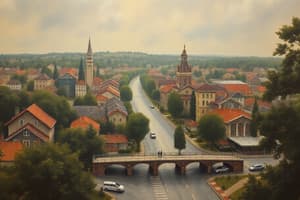Podcast
Questions and Answers
What is a consequence of removing residential areas in a community?
What is a consequence of removing residential areas in a community?
- More recreational areas
- More crowding and increased homelessness (correct)
- Less traffic congestion
- Increased access to goods
Urban sprawl is associated with decreased traffic congestion.
Urban sprawl is associated with decreased traffic congestion.
False (B)
Name one economic impact of urban sprawl.
Name one economic impact of urban sprawl.
Higher transportation costs
Without recreational areas, a community might experience a lack of physical health and ________.
Without recreational areas, a community might experience a lack of physical health and ________.
Match the patterns of urban sprawl with their descriptions:
Match the patterns of urban sprawl with their descriptions:
Which of the following is a pro of urban sprawl?
Which of the following is a pro of urban sprawl?
Sustainable urban planning aims to promote environmentally and economically sustainable communities.
Sustainable urban planning aims to promote environmentally and economically sustainable communities.
What is one environmental impact of urban sprawl?
What is one environmental impact of urban sprawl?
Flashcards
Urban Sprawl
Urban Sprawl
A way of spreading out homes and businesses over wide areas.
Scattered Development
Scattered Development
Homes situated far from the center of the city.
Low-density Development
Low-density Development
Buildings on large plots of land, with fewer homes per acre.
Increased Traffic Congestion
Increased Traffic Congestion
Signup and view all the flashcards
Lower Housing Prices in Sprawl
Lower Housing Prices in Sprawl
Signup and view all the flashcards
Limited Public Transportation
Limited Public Transportation
Signup and view all the flashcards
Economic Inefficiencies of Sprawl
Economic Inefficiencies of Sprawl
Signup and view all the flashcards
Sustainable Urban Planning
Sustainable Urban Planning
Signup and view all the flashcards
Study Notes
Urban Sprawl
- Urban sprawl involves the spread of urban areas into surrounding rural land.
- Four patterns of urban sprawl: low-density development, scattered development, spare street network, and commercial development.
Pros of Urban Sprawl
- More housing options, potentially including single-family homes.
- Possibly lower housing prices.
Cons of Urban Sprawl
- Increased traffic congestion
- Higher transportation costs (fuel, maintenance, time in traffic)
- Environmental impacts (habitat loss, deforestation, pollution)
- Limited public transportation
- Inefficient land use and increased costs for services like water and sewage
- Increased energy consumption and greenhouse gas emissions
Addressing Urban Sprawl Challenges
- Sustainable urban planning: An approach to city and regional planning focusing on environmental, social, and economic sustainability.
Studying That Suits You
Use AI to generate personalized quizzes and flashcards to suit your learning preferences.




